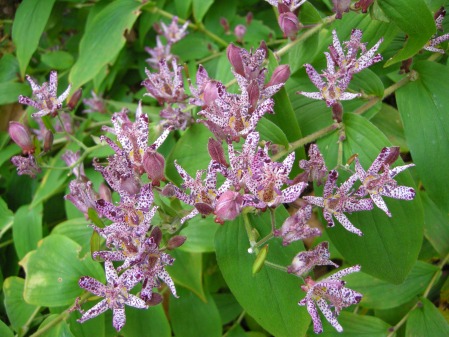Carolyn’s Shade Gardens is a retail nursery located in Bryn Mawr, PA, specializing in showy, colorful, and unusual plants for shade. The only plants that we ship are snowdrops within the US. For catalogues and announcements of local events, please send your full name, mailing address, and cell number to carolyn@carolynsshadegardens.com and indicate whether you are interested in snowdrops, hellebores, and/or hostas. Click here to get to the home page of our website for catalogues and information about our nursery and to subscribe to our blog.

I love toad-lilies and have grown more than a dozen cultivars— some successfully, some not. For several reasons, my favorite by far is ‘Sinonome’. If you haven’t already fallen for it after seeing its photo above I will tell you why ‘Sinonome’ is so desirable.
First and foremost ‘Sinonome’ blooms in October and November when almost every other flower is done, and I am waiting for hellebores. The gracefully arching 3′ stems are loaded from top to bottom with ruby-purple spotted orchid-like flowers. As a bonus, its deep green, shiny leaves are quite ornamental and appear in early spring, unlike many fall bloomers that take their time coming out of the ground.
‘Sinonome’ is very easy to grow in part to full shade and takes dry conditions. I have it growing in three places: on a steep slope with high shade, at the base of a London plane tree in dense dry shade, and under an American hornbeam in a full shade bed filled with surface roots. It thrives in all these locations. Unfortunately, my deer like it.

Companion Plants: My ‘Sinonome’ is planted with hosta cultivars that still look good in late fall, like ‘Paul’s Glory’ in the photo. I also have it paired with Italian arum, which re-emerges in fall looking fresh and beautiful, maiden hair and other ferns, and hellebores. It makes a great specimen all on its own, filling the space of a small shrub.
Other Toad-lilies: If you want to branch out from ‘Sinonome’, try ‘Empress’ with similar flowers but an upright habit. I also like Tricyrtis ‘White Towers’, a smaller plant with white flowers, and Tricyrtis latifolia, another smaller plant but with yellow spotted flowers. All these toad-lilies have thrived for many years in my garden while others have died. I believe that many poorly selected toad-lilies have been introduced; either that or they just don’t like the mid-Atlantic.
Culture: Aside from part to full shade, all toad-lilies need to thrive is good drainage. Even though most authorities say they need moist soil, I have never lost a toad-lily to drought, and I never water them—even this past summer (my plants are more loaded down with blooms than ever before). I have had toad-lilies die from poor drainage though. As always, they benefit from compost added at planting and from being mulched with ground leaves.
Carolyn







